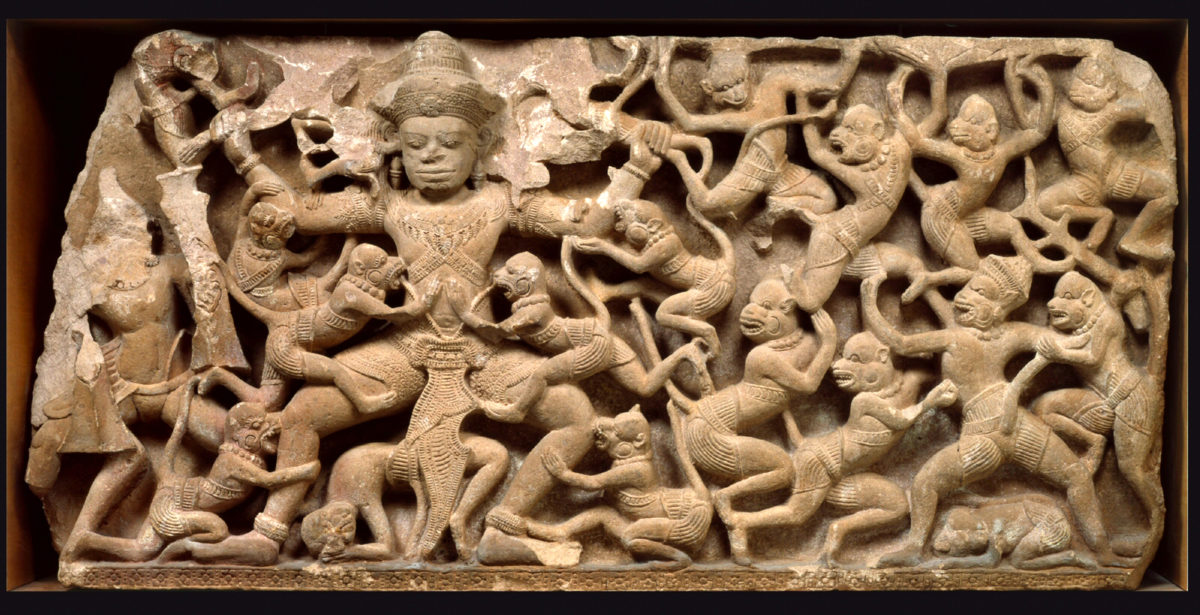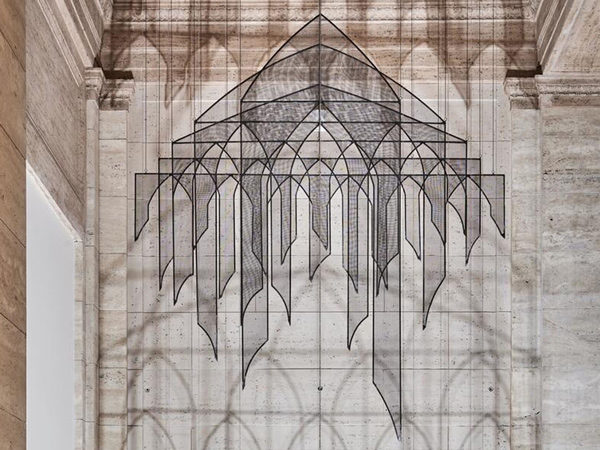Activity
Shadow Theater – Bringing Your Character to Life
Objective: Students use visual evidence to convey character by constructing a visual identity for their shadow puppet, and demonstrate principles of shadow-casting and puppet-making by performing their shadow play.

English Language Arts: Literary analysis: 3.3, 4.3; Visual and Performing Arts: Artistic Perception: 3.1.4, 6.1.3; Creative Expression: 4.2.6, 5.2.7; Connections, Relationships, Applications: 6.5.3; Theatre: 3.1.2, 4.1.2, 5.2.0, 5.2.2, 5.3.2, 6.1.2, 6.3.2, 6.5.2; Music: 3.3.1, 3.3.2; Science/Physical Sciences: 3.2
Author: Sarah Willner, Music Integration Specialist.
Materials:
Artwork (see “Related Resources” below): Kumbakarna Battles the Monkeys (lintel); Kumbhakarna; Worksheet (see “Downloads” above: Shadow Puppet Template; Other Materials: Manila folder paper; Scissors + hole punchers; Tape; Sticks to move the puppets’ parts; 1 or 2 overhead projectors; Overhead transparencies; Pencils; Fine-point Expo whiteboard markers; White butcher paper clear-taped together to make a screen. (Tape long thin rope across the top. Use this to hand and secure the screen.); Shadow puppets and/or other puppets, dolls, or anything else that can cast a shadow;
*Teacher can cut out the puppet from the template to demonstrate how to make movable parts;
*Older students can work with a mat knife to cut out fine work on the puppets. If you use mat knives, put down some cardboard or a cutting board to cut onto.
Procedure:
Making Your Puppet
- Project Kumbhakarna Battles the Monkeys (see “Related Artworks” below). Ask students to identify each character and support their identification with visual evidence.
- Explain that shadow puppet performances are still a popular way to recall the lessons of the Story of Rama. Show the shadow puppet of Kumbhakarna. Have students compare and contrast the two depictions of Kumbharkarna.
- Explain how shadow puppets work by pointing to hinges and sticks.
- Show the KQED video Larry Reed: Spark or another video so students can get an understanding of how the person and puppet move with the screen and light.
- Give each student a manila folder. Using pencil, they may draw and transfer either their noble or demon character onto it. Remember: If they want to have a moving part, they must overlap the parts to be able to put a brad in to join them. For example, the shoulder must stick out a bit from the body. To join it with the arm, place the puppet’s arm over the shoulder, and join them with a brad. Plan whether you want moving parts, and draw those away from the body.
- Cut out each part.
- Make any cut-outs you want so that the light can come through. You can hole-punch eyes, or a belt of light. Older students or teacher/helpers can make cut-outs with mat knives.
- Make a small hole and join any moving parts with a brad.
- Color your puppet to make it even more expressive. Remember, some of your audience may sit behind the screen, as in Bali.
- Attached any sticks you need to the moving parts with small bits of tape.
- Try it in front of the light!
- Mid-project reflection: Does your puppet look like you want it to in shadow? (Get used to seeing the shadow; sometimes students draw on the puppet, but it doesn’t look as subtle in shadow.) Make adjustments.
Bringing Your Puppets to Life
- Experiment with how your puppet character might move. What kind of voice does your character have? Say something in that voice.
- Have each student take a turn introducing her or his puppet behind the screen. Challenge students in pairs or small groups to make a still tableau with their puppets. For example, maybe the demon is flying overhead, while the noble woman is striding along hand-in-hand with a noble tiger. Maybe another demon is lurking in some underbrush.
- In small groups, students make a short (1–2 minute) scene with their puppets that has a beginning, middle, and end. Each student can speak for his or her own character, or have a narrator.
- Add scenery. Students can experiment drawing a landscape on an overhead transparency, or have one student hold scenery, such as branches or other objects that the puppets use. Share/perform their scenes.
- Students can also use their bodies in back (and even in front!) of the screen to interact with the puppets behind the screen.
- Reflect: What was hard about this project? How did you persevere through it? What new skills did you learn? What was the most fun part of this project?
Optional Activities Before You Create Your Shadow Puppets:
Introduction to Balinese Shadow Theater
Lesson Duration: 1.5 hrs.
Watch and discuss the film Shadow Master. If possible, handle or view Balinese shadow puppets. Notice and discuss how the parts are moved; notice where the latticework is cut into the puppet.
Shadow Party: Experiment with Shadows
Lesson Duration: 1 hour
Preparation Duration: 45 minutes of teacher preparation to hang the screen, position the overhead projector(s), cut out model puppet parts.
*Before the rotations, demonstrate each station. Then demonstrate how to interact onscreen; for example, how to make a shadow bigger (get close to the light source). How can characters touch each other onscreen without touching in real life?
Station 1: Casting shadows on the overhead projector with leaves, small puppets, or dolls
Station 2: Casting shadows with puppets on one side of the screen
Station 3: Casting shadows with your body on the other side of the screen
Station 4: At the 2nd overhead projector casting shadows with some scenery on pre-drawn overhead transparencies of landscapes, buildings, etc.
Station 5: Accompany the action quietly with some instruments. Really follow the action! If there is no music, one station could be improvising a narration of the action.
Default Station: In front of the screen as the audience!
Students can take turns being “onscreen” when they are in their station. For example, if one group is at the station to cast shadows with their full bodies, have them take turns waiting off screen, going one by one onto the screen for a minute.
*If this activity is too busy, try having fewer stations, such as only station 1 and 3 going on at once, for example.
*If you can, hang two screens and have stations at both screens.







